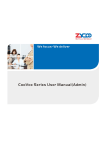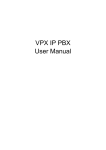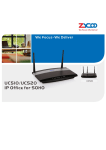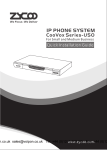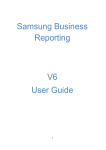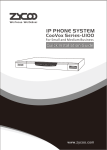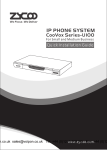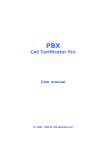Download CooVox Series User Manual
Transcript
Table of Contents CHAPTER 1 BRIEF INTRODUCTION.......................................................................................... 1 1.1 Brief Introduction of CooVox Series ................................................................................. 1 1.2 Main Features ................................................................................................................ 2 1.3 Module .......................................................................................................................... 3 1.4 Hardware Interface ........................................................................................................ 4 1.4.1 CooVox-U20 ............................................................................................................ 4 1.4.2 CooVox-U50 ............................................................................................................ 5 1.4.3 CooVox-U100 .......................................................................................................... 7 1.4.5 Model Comparison Table .......................................................................................... 8 1.4.6 Environmental Requirements .................................................................................... 9 1.4.7 Packing List ................................................................................................................ 9 CHAPTER 2 GETTING STARTED .................................................................................................. 10 2.1 Before Configuration .................................................................................................... 10 2.2 Before Making a Call .................................................................................................... 10 2.2.1 Login IP PBX ............................................................................................................. 10 2.2.2 Basic Configuration ................................................................................................ 12 2.2.3 Time Based Rules .................................................................................................. 15 2.3 Outbound Call ............................................................................................................. 16 2.3.1 Trunks .................................................................................................................. 16 2.3.2 Outbound Routes .................................................................................................. 18 2.4 Inbound Call ................................................................................................................ 20 2.4.1 Inbound Routes ..................................................................................................... 20 2.4.2 IVR ....................................................................................................................... 22 2.4.3 IVR Prompts .......................................................................................................... 24 2.4.4 Ring Groups .......................................................................................................... 25 2.4.5 Blacklist ................................................................................................................ 26 2.4.6 Call Pickup ............................................................................................................ 27 2.5 During a Call ............................................................................................................... 27 2.5.1 Call Parking ........................................................................................................... 27 2.5.2 Call Transfer .......................................................................................................... 28 2.6 User Extension Settings 2.6.1 Follow me Settings .......................................................... 29 2.6.2 Call Recording ....................................................................................................... 29 2.6.3 Call Forward ............................................................................................................. 30 2.6.3 Voicemail .............................................................................................................. 30 2.7 Call Center(Call Queues) .............................................................................................. 32 2.7.1 Create Agent ......................................................................................................... 32 2.8 Conference Bridge .................................................................................................... 35 HAPTER 3 ADVANCED .............................................................................................................. 38 3.1 Options ....................................................................................................................... 38 3.2 Voicemail..................................................................................................................... 40 3.3 SMTP Settings ............................................................................................................. 41 3.4 Email to Fax ................................................................................................................ 42 3.5 Music Settings ............................................................................................................. 43 3.6 DISA ........................................................................................................................... 44 3.7 Follow Me .................................................................................................................... 45 3.8 Paging and Intercom .................................................................................................... 46 3.9 PIN Sets ...................................................................................................................... 47 3.10 Call Recording ............................................................................................................ 48 3.11 Speed Dial ................................................................................................................. 49 3.12 Smart DID ................................................................................................................. 49 3.13 Callback .................................................................................................................... 50 3.14 Phone Book ............................................................................................................... 51 3.15 Feature Codes............................................................................................................ 51 3.16 IP Phone Provisioning ................................................................................................. 53 CHAPTER 4 NETWORK SETTINGS........................................................................................... 55 4.1 Network ...................................................................................................................... 55 4.2 Static Routing .............................................................................................................. 56 4.3 VPN Server .................................................................................................................. 57 4.4 VPN Client ................................................................................................................... 58 4.5 DHCP Server ................................................................................................................ 59 4.6 DDNS Settings ............................................................................................................. 60 4.7 SNMPv2 Settings .......................................................................................................... 60 4.8 Trouble Shooting .......................................................................................................... 61 CHAPTER 5 SECURITY ............................................................................................................... 62 5.1 Firewall ....................................................................................................................... 62 5.2 Service ........................................................................................................................ 62 CHAPTER 6 REPORT .................................................................................................................. 63 6.1 Record List .................................................................................................................. 63 6.2 Call Logs ..................................................................................................................... 63 6.3 System Logs ................................................................................................................ 64 CHAPTER 7 SYSTEM .................................................................................................................... 65 7.1 Time Settings............................................................................................................... 65 7.2 Data Storage ............................................................................................................... 66 7.3 Management................................................................................................................ 67 7.4 Backup ........................................................................................................................ 67 7.5 Reset & Reboot ............................................................................................................ 68 7.6 Upgrade ...................................................................................................................... 68 7.6.1 WEB Upgrade ........................................................................................................ 68 7.6.2 TFTP Upgrade ....................................................................................................... 69 CHAPTER 8 OPERATING INSTRUCTION ............................................................................................... 69 8.1 How to connect CooVox-U50 in the Network .................................................................. 69 8.2 How to combine two sets CooVox IP PBX in the same network ....................................... 70 8.3 How to connect two sets CooVox IP PBXs in different network? ...................................... 72 8.4 How to resolve the problem “one-way” audio problems .................................................. 75 8.5 How to use Skype on CooVox-U50 ................................................................................ 75 8.5.1 Visit the top-up page ............................................................................................. 75 8.5.2 Manage Skype account .......................................................................................... 75 8.5.3 Create a SIP file .................................................................................................. 76 Safety Notice Please read the following safety notices before installing or using this IP PBX. They are crucial for safe and reliable operation of the device. Failure to follow the instructions contained in this document may result in damage to your PBX and void the manufacturer’s warranty. 1. Please use the external power supply which is included in the package. Other power supplies may cause damage to the device, affect the performance or induce noise. 2. Before using the external power supply in the package, please check your building power voltage. Connecting to Inaccurate power voltage may cause fire and damage. 3. Please do not damage the power cord. If the power cord or plug is impaired, do not use it. Connecting a damaged power cord may cause fire or electric shock. 4. Ensure the plug-socket combination is accessible even after the PBX is installed. In order to service the PBX it will need to be disconnected from the power source. 5. Do not drop, knock or shake the device. Rough handling can break internal circuit boards. 6. Do not install the device in places where there is direct sunlight. Also do not place the device on carpets or cushions. Doing so may cause the device to malfunction or cause a fire. 7. Avoid exposing the device to high temperature (above 40°C), low temperature (below -10°C) or high humidity. Doing so could cause damage and will void the manufacturer warranty. 8. Avoid letting the device come in contact with water or any liquid which would damage the device. 9. Do not attempt to open it. Non-expert handling to the device could cause damage and will immediately void the manufacturer warranty. 10. Consult your authorized dealer for assistance with any issues or questions you may have. 11. Do not use harsh chemicals, cleaning solvents, or strong detergents to clean the device. 12. Wipe it with soft cloth that has been slightly dampened in a mild soap and water solution. 13. If you suspect your device has been struck by lightning, do not touch the device, power plug or phone line. Call your authorized dealer for assistance to avoid the possibility of electric shock. 14. Ensure the PBX is installed in a well ventilated room to avoid overheating and damaging the device. 15. Before you work on any equipment, be aware of any hazards involved with electrical circuitry and be familiar with standard practices for preventing accidents. situation that could cause bodily injury. If you are in a Copyright ©ZYCOO All rights reserved. V1.0 Chapter 1 Brief Introduction 1.1 Brief Introduction of CooVox Series The CooVox Series IP PBXs are designed to provide SMEs (small & medium enterprises) with all the standard and many advanced features that are normally only available from large, expensive, legacy PBX manufacturers. Aimed at businesses with up to 100 extensions, the CooVox Series IP PBXs are based on SIP and OpenSource Asterisk 1.8, With its innovative modular telephony design, it is easy to expand the PBX to meet the growing needs of your business. CooVox Series IP PBXs come in three sizes: U20/ U50/ U100. Each model will be introduced in detail below: CooVox-U20 is configured with 2 analog ports: FXS FXO 1 1 0 2 CooVox-U20 CooVox-U50 consists of two main parts:U50 Host and the Telephony Modules. There are 2 slots in the system and the modules can be utilized as in the diagram below: U50 Slot Slot 1 Slot 2 U50 Module 4FXS 4FXO 2FXOS 2GSM 4GSM 4BRI 1E1/T1 CooVox-U100 consists of two main parts:U100 Host and Modules. There are 2 slots in the system and the modules can be utilized as in the diagram below: U100 Slot Slot 1 U100 Module 4FXS 4FXO 2FXOS 2GSM 4GSM 4BRI 1E1/T1 1 Slot 2 Copyright ©ZYCOO All rights reserved. V1.0 1.2 Main Features 1. SIP/ IAX Extension Registration 2. Video Call 3. USB Mobile Hard Disk Record (Scalable) 4. IP Phone Provisioning (Grandstream /Yealink/Fanvil IP Phone) 5. Call Record /Ring Group Record/ Call Queue Record 6. Web-based Administration and configuration 7. Web-based Extension User Management 8. Voicemail 9. Caller ID 10. Call Parking 11. Call Forward 12. Call Transfer 13. Call Waiting 14. Call Center Queues 15. Black List 16. Phonebook 17. Flexible Dial Plan 18. Virtual Fax (fax to email, and email to fax) 19. DID 20. Dial by Name 21. Speed Dial 22. Do Not Disturb 23. Callback 24. Skype for SIP 25. Ring Group 26. Conference Bridge (Three Conferences) 27. Music On Hold 28. DISA (Direct Inward System Access) /Paging And Intercom 29. Call Detail Record 30. IP Phone Feature Code 31. BLF(Busy Lamp Field) 32. Static /DHCP /PPPoE Network Access 33. DHCP Server 34. System Backup 35. T.38 Pass-through 36. Audio Codec: G.722/ G.711-Ulaw/ G.711-Alaw/ G.726/ G.729/ GSM/ SPEEX 37. Video Codec: H.261/ H.263 / H.263+ / H.264 38. VPN Server (L2TP / PPTP / OpenVPN, up to 10 connections for VPN clients) 39. VPN Client (L2TP / PPTP / OpenVPN / N2N) 40. SNMPv2 41. IPv4 / IPv6 42. DDNS(Dyndns.org /No-ip.com /zoneedit.com) 2 Copyright ©ZYCOO All rights reserved. V1.0 1.3 Module 4FXS Module 4FXO Module 2FXOS Module 2GSM Module 4GSM Module 4BRI Module 1E1/T1 Module 32 EC Module 3 Copyright ©ZYCOO All rights reserved. V1.0 1.4 Hardware Interface 1.4.1 CooVox-U20 CooVox-U20 Front Panel CooVox-U20 Back Panel 1. 1 * Reset Button 2. 1 * Power Interface (DC 12V 2A) 3. 1 * Ethernet Interface (10/100Mbps) 4. 2 * Analog Ports(FXO/FXS) 5. 1 * UMTS Port 4 Copyright ©ZYCOO All rights reserved. V1.0 U20 LEDs Indication Indication PWR SYS ETH G 1 2 Function Status Explaination On Power On Off Power Off Blink System Works Off System Fails Blink Data Transport Off Module not running 64ms On/800ms Off Module doesn’t find network 64ms On/3000ms Off Module finds network Red Module Loading Success Blink Channel Ringing Off Module Loading Failure Green Module Loading Success Blink Channel Ringing Off Module Loading Failure Power Status System Status WAN or LAN Data Status GSM or UMTS(3G) Status FXO FXS 1.4.2 CooVox-U50 CooVox-U50 Front Panel CooVox-U50 Back Panel 1. 1 * Reset Button 2. 1 * Power Interface (DC 12V 2A) 3. 1 * Ethernet Interface (10/100Mbps) 4. 1 * Console Interface 5. 1 * USB Interface 6. SLOT 1 for Analog/ GSM/ E1/T1/ BRI Module Card 7. SLOT 2 for Analog/ GSM Module Card Only 5 Copyright ©ZYCOO All rights reserved. V1.0 U50 LEDs Indication Indication PWR SYS ETH USB Function Status On Power On Off Power Off Blink System Works Off System Fails Blink Data Transport Off No Data Transport Off Module not running On Module Works Power Status System Status Data Status U-disk or UMTS(3G) Status FXS FXO GSM E1/T1 L1 (PRI/ 1-4(SLOT1) SLOT 1 Status R2) L2 L3 L4 BRI FXS 1-4(SLOT2) Explaination SLOT 2 Status FXO GSM 6 Green Module Loading Success Blink Channel Ringing Off Module Loading Failure Red Module Loading Success Blink Channel Ringing Off Module Loading Failure Red Module Loading Success Blink Channel Ringing Off Module Loading Failure Red Module Loading Success Off Module Loading Failure Red CPE signal Green NET signal Off No signal Red SS7 signal Green MFCR2 signal Off No signal Red Disconnected/ Alarm Green Connected/ No Alarm Red TE Mode Green NT Mode Off Module Loading Failure Green Module Loading Success Blink Channel Ringing Off Module Loading Failure Red Module Loading Success Blink Channel Ringing Off Module Loading Failure Red Module Loading Success Blink Channel Ringing Off Module Loading Failure Copyright ©ZYCOO All rights reserved. V1.0 1.4.3 CooVox-U100 CooVox-U100 Front Panel CooVox-U100 Back Panel 6. 1 * Reset Button 7. 1 * Power Interface 8. 1 * Power Switch 9. 2 * Ethernet Interfaces (10/100 Mbps) 10. 1 * VGA Interface 11. 2 * USB Interfaces 12. 2 * Audio Interfaces 13. SLOT 1 for Any Module Card 14. SLOT 2 for Any Module Card 7 Copyright ©ZYCOO All rights reserved. V1.0 U100 LED Indication Indication Function PWR Power Status SYS System Status ETH Data Status Status On Power On Off Power Off Blink System Works Off System Fails Blink Data Transport Off No Data Transport FXS FXO GSM E1/T1 L1 L2 1-4(SLOT1/2) Explaination SLOT 1 /2 Status L3 L4 BRI Green Module Loading Success Off Module Loading Failure Red Module Loading Success Off Module Loading Failure Red Module Loading Success Off Module Loading Failure Red Module Loading Success Off Module Loading Failure Red CPE signal Green NET signal Off No signal Red SS7 signal Green MFCR2 signal Off No signal Red Disconnected/ Alarm Green Connected/ No Alarm Red TE Mode Green NT Mode Off Module Loading Failure 1.4.5 Model Comparison Table Items System Capacity CooVox-U20 CooVox-U50 CooVox-U100 Concurrent Calls 10 12 80 Extension Users 30 100 500 21,000 mins (GSM/ 21,000 mins (GSM/ 2,500,000 or 100,000 default) default) mins Voicemail Recording and (GSM/ default) 3000 mins (wav) 3000 mins 270,000 or 10,000 mins (wav) (wav) Hardware SDRAM 128MB DDR2 256MB DDR2 2GB DDR3 Capacity Memory (default) 4GB SD card 4GB SD card 500GB HDD or 32GB SSD Power Supply Input 100-240Vac 100-240Vac Output DC 12V/1A DC 12V/2A 8 100-240Vac Copyright ©ZYCOO All rights reserved. V1.0 1.4.6 Environmental Requirements 1. Working Tempreture: 0 °C ~40 °C 2. Storage Tempreture: -30 °C ~ 65 °C 3. Humidity: 0~95% No Dew 1.4.7 Packing List 1. CooVox Host 1 set 2. Power Supply 1 piece 3. Ethernet Cable 1 piece 4. Quick Installation Guide 1 piece 5. Warranty Card 1 piece Notice: 1) ZYCOO Module cards will only function in CooVox IP PBX from ZYCOO; 2) Module cards for CooVox-U50/U100 will be packed separately but contained in the same package. 9 Copyright ©ZYCOO All rights reserved. V1.0 Chapter 2 Getting Started (Take CooVox-U50 as example for the guide) 2.1 Before Configuration What kind of IP Phones can be used with this device? 1. 2. SIP Extension: CooFone Series and ZP Series IP Phones provided by ZYCOO (D30/ D30P/ D60/ ZP302/ ZP502/ ZP502P) Any standard SIP Phone based on SIP/ IAX2 protocol (eg: CISCO, Grandstream, Yealink, Polycom, Siemens, Snom,etc.) 2.2 Before Making a Call 2.2.1 Login IP PBX Getting IP Address There are three ways to set the IP address: Static, DHCP, PPPoE. Default IP: 192.168.1.100:9999 Notice: you have to add port number 9999 after this IP address. Defaults and Function Key 1. Web Panel User name: admin 2. Web Panel Password: admin 3. *60 Enter Voicemail Box 4. 900/901/902 Default three conference room numbers 5. # Blind Transfer 6. *2 Attended Transfer 7. * Disconnect Call Administrator Login After connecting the CooVox IP PBX to the local area network and setting your laptop to the 192.168.1.x subnet, launch the web browser and bring up the system login page by entering the following URL: http://192.168.1.100:9999. You will see the login interface as below: 10 Copyright ©ZYCOO All rights reserved. V1.0 Input username and password, press the “Login” button and you will see the configuration interface below. 1. Default username: admin and password: admin Notice 1. Please use IE(7.0 or higher version), Chrome, Firefox web browser. 2. If you do not see the interface above after inputting default IP and port number, please check whether your computer IP address is in the same segment with your IP PBX. 3. For Security reasons, please modify the username and password after login successfully. You can modify these by selecting: 【System】---【Management】 4. With the default setting, if there is no activity on the page for more than one minute, the system will timeout and automatically log out To continue making configuration changes, you will need to login again. 2. Network WAN IP and MAC will be displayed 3. Storage Total storage and used storage will be displayed 4. Channels Channel information will be displayed based on the modules installed 5. Device Info Model No. And system version will be displayed 11 Copyright ©ZYCOO All rights reserved. V1.0 Commonly Used Buttons On the home page, besides system info, there are other function buttons as below: 1. Logout Logout the Web panel 2. Activate Changes Activate the changes for your current configuration System Menu System Menu includes the following sub menu: 1. Home Display device information 2. Operator Extension / Trunk / Channel Status 3. Basic Basic configuration on extension, trunks, etc 4. Inbound Control Configuration of Inbound Route, IVR and Black List, etc 5. Advanced Configuration of extension's default information, Conference Call, Call Transfer, Function Key, etc. 6. Network Settings Configuration of Routing, Network, VPN, DHCP and other related network parameters 7. Security: Configuration of Firewall, SSH, FTP. 8. Report Record List, Call Logs and System Logs. 9. System Time Settings, Management, Back Up and Upgrade, etc. 2.2.2 Basic Configuration Extension Configuration CooVox Supports SIP/ IAX2 and analog extensions as well as the ability to ”Batch Add Users” by uploading extensions file. Click【Basic】->【Extensions】to configure: 12 Copyright ©ZYCOO All rights reserved. V1.0 Click【New User】to see the extension configuration interface as below: 13 Copyright ©ZYCOO All rights reserved. V1.0 Extension Settings: Item Explanation SIP/IAX2 Choose extension protocol. Name Extension Name (English Character Only), e.g.: Tom. Extension Extension Number connected to the phone, e.g.: 888. Password Same password as voicemail. (4-16 digits, e.g.:123456) Outbound CID Override the caller ID when dialing out with a trunk. Dial Plan Please choose the Dial Plan which is defined in the menu “Outbound Routes”. Analog Phone Please select the relative FXS port for your analog phone. Voicemail Check this option to enable the voicemail account VM Password Set password for Voicemail, For security reasons, do not use the extension number or any easy combination like "1234" Delete VMail Check this option to delete voicemail from the PBX after it’s sent by email. Email Extension user’s email address to receive email messages with attached fax or (FAX/Voicemail) voicemail (you need configure the fax to email/voicemail options), e.g.: [email protected] Web Manager Allow this user to login to the Extension Management Panel to manage extension options including voicemail, call recording, call transfer, etc when you select this option. Agent Check this option to set this extension user as agent. Call Waiting Enable call waiting Allowing Being Spied Check this option to allow this extension to be monitored (listened to or “spied”). NAT Check this option if extension user or the phone is located outside the NAT(Network Address Translation) available gateway. Pickup Group Select the Pickup Group which the extension user belongs to. Mobility Extension After check this option, you must set mobility extension number. User can make calls to the IP PBX server with this mobility number, and have all rights of this extension, e.g.: Outbound Call, Internal Call, Listen to the voicemail. Transport Select the Transport Protocol: UDP, TCP, TLS SRTP Enable SRTP (Secure Real-time Transport Protocol) DTMF Mode Default DTMF is rfc2833. It can be changed if necessary.. Video Call Check to enable video calling for this extension. And select the video codecs you need to use. Permit IP Set device ip address or subnet permitted to register this extension with the IP PBX, e.g.:192.168.1.77 or 192.168.10.0/255.255.255.0. Devices with other IP addresses are not allowed to register this extension with the IP PBX. Audio Codecs Select what audio codecs you need to use. Notice: 1. There are 30 default extensions which number started with “8”*; you can add or delete extension by your requirement. 2. Maximum extensions: 100 14 Copyright ©ZYCOO All rights reserved. V1.0 Upload/Download Extensions Click【Upload/Download Extensions】to batch add extensions as below: Download the extension template from the【Download Extensions Template】, open the template using an editor or application like Microsoft Excel and carefully add extension information based on the template format and save. Select the extension file to upload from【Upload Extensions】 Download current extensions information from【Download Extensions(.csv)】 2.2.3 Time Based Rules Create a Time Rule. For example, BusinessHours. Select the starting and ending time, starting and ending days of the week, specific start and end dates and/or start and ending month of the year. When an inbound call is processed, if the current time of the PBX is within these parameters, then the “if time matches” destination will be used for the call. If the current time of the PBX is outside these parameters, then the “if time does not match” destination will be used for the call. Please set from this page:【Time Based Rule】---【New Time Rule】: 15 Copyright ©ZYCOO All rights reserved. V1.0 New Time Rule: Item Explanation Rule Name Define the name for this Time Rule. Time&Date Conditions Set parameters for Time/Day/ Date/ Month. Destination Select destination if time matches or does not match the conditions set. For example for BusinessHours, “if time matches”, select operator extension during BusinessHours. If outside business hours, select “if time does not match” destination of Operator voicemail 2.3 Outbound Call 2.3.1 Trunks If you want to set up outbound route connected to PSTN (Public Switch Telephone Network) or VoIP provider, please configure on this page:【Basic】->【Trunks】 CooVox supports two kinds of trunks for your choice: VoIP or SIP Trunk and FXO/GSM/PRI/BRI Trunk. 16 Copyright ©ZYCOO All rights reserved. V1.0 How to add each trunk: VoIP Trunks Click【VoIP Trunk】->【New VoIP Trunk】: VoIP Trunks Reference: Item Explanation Description Description of SIP trunk. Protocol Select protocol for outbound route, SIP or IAX2. Host Set host address (provided by VoIP Provider). Maximum Channels Set maximum channels for simultaneous call. (Only for outbound call; “0” = no limitation). Prefix The prefix will be added in front of your dialed number automatically when the trunk is in use. Caller ID This Caller ID will be displayed when user make outbound call. Note: This function must be supported by local provider. Without Authentification If your trunk is static IP based and does not require a registration string when connecting the CooVox IP PBX, check this option. Username Username provided by VoIP Provider. Password Password provided by VoIP Provider. Advanced Options Advanced options for this trunk, e.g.: codecs, dialplan, etc. The outbound trunk will be in the list of VoIP Trunk when the trunk is added successfully. 17 Copyright ©ZYCOO All rights reserved. V1.0 FXO/GSM Trunk Click【FXO/GSM Trunk】->【New FXO/GSM Trunk】: FXO/GSM Trunk Reference: Item Explanation Description Description for this trunk. Lines Check one or more channels (FXO or GSM) to be included in this trunk group Prefix The prefix will be added to the dialed number automatically when this trunk is in use. Advanced Options Advanced Options for this trunk, e.g.: Call Method, Busy Detection, etc. Select one or more of the available channels to be used for this trunk group. Note: each channel can only be included in one trunk group. If no channels appear then all available channels are already defined. BRI / PRI Trunk Please set up BRI/PRI trunk similarly to the FXO/GSM trunk settings above. 2.3.2 Outbound Routes Outbound Routes are used to define which trunk groups are used by a specific extension when placing outbound calls. If you don't allow an extension user to place external calls, please ignore this part. Please configure on this page: 【Basic】->【Outbound Routes】 18 Copyright ©ZYCOO All rights reserved. V1.0 You can configure the basic match pattern of outbound routes and create different dial plan on this page. Create as many different dial plans as you need to determine how you need extensions to be allowed to make calls. For example, create “InternalDialPlan” to include all Internal Calling Rules but do not select any outbound dial rules. Select “InternalDialPlan” for all extension users that do not need the ability to make external calls. Click【DialPlans】->【New DialPlan】: 19 Copyright ©ZYCOO All rights reserved. V1.0 You can create one or more DialRules for DialPlans from this page: Reference: Item Explanation Rule Name Define the name for the dial rule. Pin Set Input this Pin when you use this dial rule. Place this call through Select one of the trunk groups that have been set up to use for this dial rule Custom Pattern N any digit from 2 to 9 Z any digit from 1 to 9 X . Delete[ ]digits prefix any digit from 0 to 9 One or more digits How many digits will be deleted from what the user dialed to what is actually sent over the trunk. For example, user dialed 94166445775 and you selected to delete 1 digit, then 4166445775 is sent out the trunk. Auto-add digit[ ] If add digit “9”, when dial 12345, 912345 will be sent. 2.4 Inbound Call 2.4.1 Inbound Routes Click【Inbound Control】->【Inbound Routes】 20 Copyright ©ZYCOO All rights reserved. V1.0 General Distinctive Ring Tone:mapping the custom ring tone file, e.g.: Set distinctive ring tone as “External”, the phone will play this ring tone when receiving the call. Note: The phone must support such feature as well. Select all calls coming in on a specific port (FXO/GSM/VOIP) and select which destination (Extension User, IVR, Queue, Conference Bridge, IVR, etc) should answer those calls. Setting the label will assign this label to be displayed. Port DIDs To have incoming calls from a PSTN trunk port (FXO/GSM trunk) answered by a specific extension user, call queue, conference bridge, or IVR, please configure here: Click【Port DIDs】->【New Port DIDs】: 1. Port Select the trunk group port 2. Label Set a label for this port. Incoming calls from this port will display the specified label. 3. Destination Incoming calls will be answered by the specified destination (extension user, call queue, conference bridge, or IVR) 21 Copyright ©ZYCOO All rights reserved. V1.0 Number DIDs If you want to select the destination of inbound calls on PSTN (T1/E1/PRI) or VoIP Trunks based on the incoming DNIS (dialed number or DID). You can specify the DID and destination (user extension, queue, conference bridge, or IVR: Click【 Number DID】->【New Number DID】: 4. DID Number Set DID Number 5. Destination Select the extension for access directly(Extension User/ Call Queue/ conference/ IVR) DOD Settings To configure outbound calls from user extensions to answer with specified destinations (user extension, queue, conference bridge, IVR) , please click 【DOD Settings】->【New DOD】 6. DOD Number Set the DOD (direct outbound dial) number, and use it to match the Caller ID. 7. Destination Outbound calls will access directly to this destination (user extension, queue, conference bridge, or IVR) 2.4.2 IVR IVR (Interactive Voice Response) or Automated Attendant will allow callers to select from a specific set of options by pressing the selected digit on their telephone dial pad. Click【Inbound Control】->【IVR】: 22 Copyright ©ZYCOO All rights reserved. V1.0 Click【New IVR】to create a new IVR: Item Explanation Name Enter a descriptive name for the IVR Extension Enter a unique extension or IVR number. This number is used to access the IVR from an internal extension. Please Select Select the IVR prompt that will provide the caller with instructions on what options are available. To configure the prompt in this page:【IVR Prompt】 Repeat Loops Loop times to repeat playing the IVR prompt if the caller does not select an option. Dial Other Extension Allow user to dial other extensions besides of the listed options. Keypress Event Select the available options beside the designated digit. 23 Copyright ©ZYCOO All rights reserved. V1.0 2.4.3 IVR Prompts IVR prompts can be recorded by using any extension registered to the PBX or they can be uploaded from the “Upload IVR Prompt” section below. IVR Prompts 【IVR Prompts】 Click【IVR Prompts】----【New Voice】to create new IVR prompt: 1. File Name Define a name for this voice file. 2. Format Select the voice format,GSM/WAV(16bit) supported only. 3. Extension used for recording: Select the extension which is used for recording the IVR prompt. Click【Record】, the extension will ring, and the prompt can be recorded after picking up the phone. To hear the existing recording, please click【Play】: 24 Copyright ©ZYCOO All rights reserved. V1.0 Select the extension, click【Play】, the selected extension will ring, and you will hear the recorded prompt after picking up the phone. Upload IVR prompt 【Upload IVR prompt】 Notice: CooVox supports custom audio file with wav,gsm,ulaw,alaw format. Recordings must be smaller than 15MB. 2.4.4 Ring Groups A Ring Group (sometimes called a Hunt Group) is a way to ring a collection of extensions by dialing a single extension number. The methodology used to ring that collection of extensions is called the ring strategy. Once the timeout (number of seconds) is reached, the call will then be directed to the “if not answered” or failover destination. To configure a Ring Group Click【Inbound Control】-> 【Ring Groups】->【New Ring Group】: 25 Copyright ©ZYCOO All rights reserved. V1.0 1. Name Define a name for the Ring Group 2. Strategy Select “Ring All” or “Ring in order” 3. Ring Group Members Select the Ring Group Member from “the Available Channels”, click 4. If not answered to add. You can choose to forward the call to extension, voicemail ring group, IVR or hang up if not answered. 2.4.5 Blacklist The Blacklist feature allows the blocking of specific phone numbers by Callerid. Click【Inbound Control】->【Blacklist】->【New Blacklist】 Input the caller ID in the space provided. Once configured, future calls from this caller ID will be blocked. To maintain this list of blocked numbers, see the instructions in the following diagram: 26 Copyright ©ZYCOO All rights reserved. V1.0 Reference: Item Explanation *75 When the registered extension user inputs *75 + blacklist number, this number will be added in the list of Blacklist Number. *075 When the registered extension user inputs *075+blacklist number, this number will be deleted in the list of Blacklist Number. 2.4.6 Call Pickup This feature allows users to answer a call that is ringing on another users extension by pressing the selected feature code on their own phone as shown in the diagram below. Reference: Item Explanation *8 Input function key *8 to pick up the registered extension which is in the ring at random. This can be defined in 【Feature Codes】 ** Input function key ** and define another extension to pick up. This can be defined in 【Feature Codes】. 2.5 During a Call 2.5.1 Call Parking This feature allows a call to be placed on hold (system will play the parked number, e.g. 701) and then retrieved from any other extension by entering the parked number. After answering the call, to park the call press *2 700 on the telephone dialpad (to transfer the call to the parking lot 700). This will park the call and the system will play the parking space (e.g. 701). To retrieve the call from the parking lot, anyone can pick up any registered extension and dial the parking space number (e.g. 701) and will be connected with the parked caller. Refer to the diagram below: 27 Copyright ©ZYCOO All rights reserved. V1.0 Reference: Item Explanation Extension to Dial for Default Number: 700, Define in【Feature Codes】 Parking Calls: What Parking space or Default Number : 701 - 720. Define in【Feature Codes】 Extension to park calls on How many seconds a call Default is 45 seconds. Define in 【Feature Codes】. can be parked for 2.5.2 Call Transfer This feature allows an incoming call that is answered on one extension to be sent to another user’s extension. Refer to the diagram as below: Reference: Item Explanation Blind Transfer Default is #. Define in 【Feature Codes】 Attended Transfer Default is *2. Define in【Feature Codes】 Complete Attended Transfer Default is *, it can be used when you use *2. Define in 【Feature Code】 Timeout for answer on Default is 15 seconds. Define in【Feature Codes】 attended transfer 28 Copyright ©ZYCOO All rights reserved. V1.0 2.6 User Extension Settings 2.6.1 Follow me Settings This feature allows a call to an extension to be automatically forward to one or more internal extensions or external phone numbers. To allow the user to configure these settings, first the user must be allowed access to the User Web Portal. To do this, select the “Web Manager” box under “Other Options”. Click【Basic】->【Extension】->【Edit】the extension you want to configure. Check【Web Manager】 and【Save】 Then login the Extension Web Panel: 2.6.2 Call Recording This feature allows users to access calls they have recorded. please see the diagram below. 29 To configure this setting, Copyright ©ZYCOO All rights reserved. V1.0 2.6.3 Call Forward This feature allows calls to an extension to be automatically forwarded to a specific internal extensions or external phone number. To configure this setting, please see below: Click【Call Forward】: Reference Item Explanation Always Status Busy No Answer All incoming calls will be forwarded. Forward when extension is busy. Forward when no answer from extension. 2.6.3 Voicemail Calls that are not answered have the option to be sent to a voicemail account so the caller can leave a recorded message. Optionally, these recorded messages may be sent to a user’s email account. Click【Basic】->【Extension】->【Edit】the extension you want to configure. 30 Copyright ©ZYCOO All rights reserved. V1.0 Please enable【Voicemail】before configuration, and configure【VM Password】and【Email】. If incoming calls are not answered, when the default ring time is over, the system will play: “please leave your message and press the “#”key ”. Then voicemail will be sent to the specified mailbox by email. To Leave a Message 31 Copyright ©ZYCOO All rights reserved. V1.0 To Listen to the message using the users desk phone Notice: 1. Proper Email address is necessary to receive voicemail via email. 2. You must configure the SMTP and Email template. For detail settings, please see the detail configuration guide【Voicemail】in Chapter 3. 2.7 Call Center(Call Queues) 2.7.1 Create Agent To allow a user to be considered an agent in a Call Center queue, please check the “Agent” option for that specific user extension. Click【Basic】->【Extension】->【Edit】the extension you want to configure: Step1: Check【Agent】and【Save】 32 Copyright ©ZYCOO All rights reserved. V1.0 Step2: Click【Inbound Control】->【Call Queues】 33 Copyright ©ZYCOO All rights reserved. V1.0 Reference Item Explanation Queue Number Define an extension number to identify the queue. Label Define the label for the queue. Ring Strategy RingAll--Ring all available agents until one answers( default) RoundRobin – Starting with the first agent, ring the extension of each agent in turn until the call is answered. LeastRecent – ring the extension of the Agent who has least recently received a call FewestCalls – ring the extension of the Agent who has taken the fewest number of calls. Random – ring the extension of a random Agent. RRmemory -- RoundRobin with Memory, like RoundRobin above, except instead of the next call starting with the first agent, the system remembers which extension was was called last and begins the round robin with the next agent . Agent Check each agent that is to be a member of this specific Call Center Queue. 34 Copyright ©ZYCOO All rights reserved. V1.0 Reference: Item Agent TimeOut(sec) Explanation Specify the number of seconds to rin an agent’s extension before sending the call to the next Agent (based on Ring Strategy). Auto Pause If an Agent’s extension rings and the Agent fails to answer the call, automatically pause that agent so the stop receiving calls from the queue. Wrap-Up-Time(sec) This is the amount of time in seconds that an agent has to complete work on a call after the call is disconnected. (Default is 0, which means no wrap-up time.) Max Wait Time(sec) Calls that have been waiting in the queue for this number of seconds will be sent to the “”If not answered” destination. Max Callers Max number of the callers who are allowed to wait in the queue. (Default is 0, which means no limitation.). With this number of callers in the queue already, subsequent callers will be sent to the “”If not answered” destination. Join Empty Allow callers to enter the Queue when no Agents are available. If this option is not defined, callers will not be able to enter Queues with no available agents - callers will be sent to the ”If not answered” destination. Leave When Empty If this option is selected and calls are still in the queue when the last agent logs out, the remaining callers in the Queue will be transferred to ”If not answered” destination. This option cannot be used with Join Empty simultaneously. Auto Fill Callers will be distributed to Agent automatically. Report Hold Time Report the hold time of the next caller for Agent when the Agent is answering the call. Frequency(sec) Repeat frequency to announce the hold time for callers in the Queue.(“0” means no announcement). Announce Hold Time Announce the hold time. Announce (yes), do not announce (no) or announce once (once), it will not be announced when the hold time is less than 1 minute. Repeat Frequency(sec) Interval time to play the voice menu for callers.(“0” mean not to play). Announcement Prompt Select a prompt as the Announcements Prompt from the IVR Prompts. 2.8 Conference Bridge A conference bridge is a virtual meeting room that allows multiple callers to hear and speak to each other. The conference bridge can be protected with a password so only callers with the password can access the conference. The software supports up to three conference rooms. To configure a conference bridge, go to 【Advanced】->【Conference】: 35 Copyright ©ZYCOO All rights reserved. V1.0 Reference: Item Conference Number Explanation The number that internal callers use to access the conference room, the default number is “900”. Conference Password Password for users to access the conference, e.g.:"1234". Administrator Password Password for administrator to access the conference. Conference DialPlan Use this dialplan to invite other participants. Play hold music for the first Check this option to play the hold music for the first participant in the conference until participant another participant enters in this conference. Enable caller menu Check this option to allow the participant to access the Conference Bridge menu by pressing “*” on the dialpad. Announce callers Check this option to announce to all Bridge participants that new participant is joining the conference. Record conference Recorded conference format is WAV. Quiet Mode If check this option, all the participants in the conference can hear only, but it is not allowed to speak. Leader Wait Wait until the conference leader(administrator) entering the conference before starting the conference. 36 Copyright ©ZYCOO All rights reserved. V1.0 To join a conference, refer to the diagram as below: While in a conference, the administrator can invite new guest (extension user or external number) into the conference. (Default password for admin is 2345) As an administrator, to invite a new guest to the conference, refer to the diagram as below: 37 Copyright ©ZYCOO All rights reserved. V1.0 hapter 3 Advanced 3.1 Options General Default settings for local extension and new extension. Click【Advanced】->【Options】->【General】: Reference Item Explanation Operator Extension Set extension number for Operator. Global RingTime Set Set RingTime for every extension. Enable Transfer Check to enable Transfer. Enable Music On Ringback Check to enable Music On Ringback. Record Format Set the format for recording files. (GSM/WAV only) Defaut Setting for New User Check to enable the default settings. Extension Preferences Set the rule for extensions. 38 Copyright ©ZYCOO All rights reserved. V1.0 Global Analog Settings Click【Advance】->【Options】->【Global Analog Settings】 : Reference: Item Explanation Caller ID Detection Enable/Disable Caller ID Detection Caller ID Signaling Select the mode of Caller ID Signaling. Caller ID Start Ring--Caller ID start before ring. Polarity--Caller ID start when polarity reversal starts. CID Buffer Length Default CID Buffer Length Opermode Set the Opermode for FXO/GSM Ports. ToneZone Select the ToneZone in your country. Relax DTMF Enable/Disable Relax DTMF inspection. Echo Cancel Enable/Disable Echo Cancel Echo Training Set Echo Training (default unit: ms) Busy Detection Enable/Disable Busy Detection. Busy Count Count the Busy Detection. It will be active when enable Busy Detection. Global SIP Settings 【Global SIP Settings】is appropriate for advanced administrators. technical support department before modifying anything in this section. 39 Please contact our Copyright ©ZYCOO All rights reserved. V1.0 3.2 Voicemail Click【Advanced】->【Voicemail】->【General】 : Reference Item MaxGreeting Time(sec) Dial "0" for Operator Explanation Maximum recording length for voicemail greetings Select this option to allow callers to press Dial "0" to transfer out of voicemail to the Operator. Message Format Save the voice message as this format, WAV(16-bit) or Raw GSM. Maximum Messages Maximum voicemail messages to be allowed to leave. Max Message Time(min) Maximum Time for each message to be allowed to leave. Min Message Time(sec) MinimumTime for each message. The message will be deleted automatically if the time is less than the min message time. Say Message CallerID Play the Caller ID of the caller before playing the voice message. Say Message Duration Play the message duration before playing the voice message. Play Envelope Play the date, time and caller ID for the voicemail message. Allow Users to Review Check this option to allow users to review the voice message. 40 Copyright ©ZYCOO All rights reserved. V1.0 Click【Advance】->【Voicemail】->【Email Settings】 Reference: Item Explanation Attach voicemail to Email The voicemail will be sent as attachment to the user’s Email. Sender Name The sender’s name will be displayed when you receive the Email. From Mailbox to send email Subject Subject of the Email. Message Input the Email template. 3.3 SMTP Settings To allow email messages to be sent to users with attached voicemail and faxmail messages, the SMTP settings need to be configured. Click【Advance】->【SMTP Settings】 : 41 Copyright ©ZYCOO All rights reserved. V1.0 Reference Item SMTP Server Explanation You must set SMTP Server address or domain connected to the CooVox IP PBX, which is used for sending the voice message to Email. Port Port number for SMTP server. Default is 25, and it will be changed to 465 when you enable SSL/TLS. SSL/TSL Enable SSL/TLS. Enable SMTP Authentication If your SMTP server needs authentication, please enable this option, and configure the following. Username Input username of your Email. Password Input password of your Email. Click【Send Test】after configuration, the following diagram will be displayed to ask you to input the Email for receiving. Specify the email address and click【Send】-to send the test email. Verify that email was successfully sent or not. If no email was received, please modify the SMTP settings and retry. 3.4 Email to Fax Users can send fax by Email. Please configure as below. Click【Advanced】->【Email to Fax】 42 Copyright ©ZYCOO All rights reserved. V1.0 Check “Enable”, input username, password and IMAP Server(server format: imap.XX.com), select the DialPlan, then “Save” and “Activate”. Practical Case: To Send a fax to telephone number 85337096: In DialPlan 1, there is prefix “9” before the telephone number; you need input the 【Access Code】: 985337096 and make this the subject when sending Email. Then the fax will be sent by Email as attachment. If you need dial the extension when sending fax, e.g.: fax number: 85337096 ext.800, you need use the 【Access Code】: 985337096-800 as subject. 3.5 Music Settings Management of Music on Hold, Music on Ringback, Music on Queue. 【Music Settings】: Select the different music file for different Music. 【Music Management】 43 Copyright ©ZYCOO All rights reserved. V1.0 Item Explanation Select Music Directory Select which Music Directory you wish to load. File Display music name under the music file, you can delete it. Select Music Directory Select the file where you want to save your uploaded music. Please choose file to upload Select the music you want to upload. Note: music file must be WAV(16bit/8000Hz/Single), GSM, ulaw or alaw, and less than 15MB. 3.6 DISA This feature allows an authorized user to call into the PBX and then place an outbound call using another trunk. For example, an employee working out of the office who needs to make an international call using trunks connected to the PBX. By calling the DISA number, after PIN authentication, the caller hears dial tone and can dial the call. Please configure as below. Click【Advance】->【DISA】--【New DISA】 44 Copyright ©ZYCOO All rights reserved. V1.0 Reference Item Explanation Name Define a name for DISA. PIN Set User will be prompted to input this number when PIN Authentication is needed. Record in CDR Check to record. Response Timeout(sec) The maximum time for waiting before hanging up if the dialed number is incomplete or invalid. Default is 10 seconds Digit Timeout(sec) The maximum interval time between digits when typing extension number. Default is 5 seconds. Extension for this DISA(Optional) If you want to access DISA by dialing an extension, you can define an extension number for this DISA. Select DialPlan Select the DialPlan for this DISA. 3.7 Follow Me This feature allows callers to automatically be forwarded to one or more internal extensions and/or one or more external phone numbers when the call is not answered at the primary extension. Please configure as below: Click【Advanced】->【Follow Me】->【New Follow Me】: 45 Copyright ©ZYCOO All rights reserved. V1.0 Select an extension, set the ring duration, and add the numbers in the Follow Me List; 【Save】 and 【Activate】. List Format: E.g.: Extension Number, Ring Duration 806,30 808,20 806 rings, after 30 seconds, the call is going to 808 【Follow Me Options】 3.8 Paging and Intercom This feature allows setting up a Paging group so when the Paging extension is dialed, the listed extensions allow the caller to speak through the speaker phone. The extensions in the Paging group must use phones that support this feature. If the Duplex option is selected, and the listed extensions use phones that support Duplex, then all the phones in the paging group will be able to have two-way conversations. 46 Copyright ©ZYCOO All rights reserved. V1.0 Click【Advanced】->【Paging and Intercom】->【New Paging Group】: Reference: Item Explanation Paging Extension Define an extension for this Paging Group. Description Define a name for this Paging Group. Paging Group Members Selected devices in this Paging Group. Device List Select device(s) here to Paging Group. Paging is typically one way for announcements only. Checking this will make the paging Duplex duplex, allowing all phones in the paging group to be able to talk and be heard by all. This makes it look like an "instant conference". 3.9 PIN Sets This feature allows an administrator to specify a list of PIN codes in a PIN Set. An Outbound Route can be specified that a valid PIN code from a selected PIN Set must be used in order to have access to a give Outbound route (e.g. for long distance or international calling). Please configure as below. Click【Advanced】->【PIN Sets】->【New PIN Set】: 47 Copyright ©ZYCOO All rights reserved. V1.0 1. PIN Set Name Define the name for this PIN Set. 2. PIN List Define PIN codes in this list. 3.10 Call Recording This feature allows an administrator to enable Call Recording to record incoming and/or outgoing calls related to the specified extension. Please configure as below: Click【Advanced】->【Call Recording】->【New Call Recording】: 48 Copyright ©ZYCOO All rights reserved. V1.0 Reference: Item Explanation Extension Define an extension for recording. Call Recording Time Set the time to record. Inbound Record Check to record inbound calls. Outbound Record Check to record outbound calls. 3.11 Speed Dial This feature allows setting up system wide speed dial numbers that translate a feature code (*99) plus a two-digit code (00-99) into an external phone number. Please configure as below. Click【Advanced】->【Speed Dial】->【New Speed Dial】: E.g.: prefix is *99 , speed number is 00, destination telephone number is 85337096. When dial *9900, the call is going to 85337096 automatically. 3.12 Smart DID Smart DID: After extension user makes an outbound call, the call is ringing back to CooVox IP PBX, and directed to the extension who made the last call. Please configure as below. Click【Advanced】->【Smart DID】: 49 Copyright ©ZYCOO All rights reserved. V1.0 Check “Enable” and “Save” to make this function activate. Click【New Smart DID Rule】to display the following diagram: Input the pattern and define how many digits need to be stripped or prepend, then click “Save”--“Activate”. 3.13 Callback This feature allows an external caller to place an inbound call to the CooVpx IP PBX. The inbound call will be disconnected and subsequently the PBX will place an outbound call back to this number and forwarded to defined destination after the call is connected. Please configure as below. Click【Advanced】->【Callback】: Enable this function; select DialPlan, and define the callback rule (strip digits or prepend prefix). Click【New Callback Number】to add callback number. 50 Copyright ©ZYCOO All rights reserved. V1.0 Input callback number and define the destination. 3.14 Phone Book When incoming call Caller ID matches the number in the phone book, the name of matched number will be displayed. Please configure as below. Click【Advanced】->【Phone Book】: 3. Search 4. Show All Search by name All contacts will be displayed in the following list. Click【Create Contact】to see the following diagram: 5. Name Input contact’s name. (letter or figure only) 6. Phone Number Input Phone Number of contact. (IDD Number is available). 3.15 Feature Codes Click【Advanced】->【Feature Codes】to see the following diagram, and you can define the code for each feature. 51 Copyright ©ZYCOO All rights reserved. V1.0 Reference: Item Explanation Extension to Dial for Parking Calls Define an extension for parking calls. Extension Range to Park Calls Define the extension range for parking calls. (e.g.: 701-720) Call Parking Time(sec) Define the time for parking calls. CooVox IP PBX will return the call to the extension after this time limit has expired. Pickup Extension This feature code will pick up a call given that the callers extension and the ringing extension are in the same pickup group and call group. Pickup Specified Extension This feature code allows a caller to Pickup a call ringing on the specified extension. Default: Dial**+extension number to pickup the specified extension. Blind Transfer To Allow unattended or blind transfer while on a call based on the following steps: 1. While on a call with caller “A”, the user dials the blind transfer key sequence (in this case “#”). The system places the original call with “A” on hold, says "Transfer" then gives a dial tone. 2. dial the transferee extension or phone number you wish to transfer the call to “B” and hangup the phone. 3. The original caller “A” is transferred immediately to the transferee “B” and “B” sees the callerid of “A”. Attended Transfer To Allow attended or supervised transfer while on a call based on the following steps: 1. While on a call with caller “A”, the user dials the supervised transfer key sequence (in this case “*2”). The system places the original call with “A” on 52 Copyright ©ZYCOO All rights reserved. V1.0 hold, says "Transfer" then gives a dial tone. 2. dial the transferee extension or phone number you wish to transfer the call to “B” and wait for “B” to answer the phone and talk to “B” to introduce the call. 1. If “B” does not wish to take the call, “B” can hang up the call and you are returned to your call with “A”. 2. If “B” wishes to accept the call, you hang up the phone and caller “A” is transferred to the transferee “B”. 3. If the call goes to voicemail or you wish to abort the transfer, simply press the “disconnect call” key sequence (in this case “*”) and the transfer will be aborted and you will be back on the call with the original caller “A”. Disconnect Call Disconnect the current transfer call (for Attended transfer). Timeout for answer on attended Set the timeout value transfer(sec) One Touch Recording Configure the function key for One Touch Recording Call Forward Enable/Disable Call Forward and the settings of function keys for different forward modes. Do Not Disturb Enable/Disable “Do Not Disturb” Spy Configure the function keys for spy modes. Blacklist Add/Delete blacklist number. Voicemail Configure the function keys for entering voicemail and check extension voicemail. Invite Participant In conference, the administrator can invite people into the conference by dialing “0”. After pressing “0”, you will get dialtone, and you can dial to invite people. After the call is connected, please press ** to direct the people into the conference, or *# to hang up the current call and return to the conference. Create Conference During the call, you can dial *0 to forward to the conference with the callee. Return to conference with participant In conference, the administrator can dial “0” to invite people into the conference. After pressing “0”, you will get dialtone, and you can dial to invite the participant; when the call is connected, dial “**” to return to the conference with invited participant. Return to conference without In conference, the administrator can dial “0” to invite people into the participant conference. After pressing “0”, you will get dialtone, and you can dial to invite the participant. When the call is connected, you can dial “*#” to hang up and return the conference yourself. Pause Queue Member Extension Pause the agent, and the agent cannot receive the call. Unpause Queue Member Extension Unpause the agent, and the agent can receive the call. Others Function key for Intercom/ Paging/ Directory 3.16 IP Phone Provisioning When many IP Phones are needed, please record the MAC, extension number, and username of each phone according to the format (please take reference of the auto provision script file model for details) , then import the format file, once the phone is connected to the local 53 Copyright ©ZYCOO All rights reserved. V1.0 network, it will get the extension number and password automatically. There are two operation methods to fulfill this function, please see details as below. Enable DHCP service Click【System】->【Network Advanced】->【Enable】DHCP Server in the following diagram: Then Click【Advanced】->【Phone Provisioning】->【New Phone】: Enable Phone Provisioning in【Basic】, select the IP Phone manufacture, input MAC of the phone, and select the extension for provisioning. Notice CooVox IP PBX supports IP Phones from Fanvil/ Yealink/ Grandstream now. 54 Copyright ©ZYCOO All rights reserved. V1.0 Chapter 4 Network Settings 4.1 Network You can configure the WAN Port, and define the Virtual Interface. Click【Network Settings】->【Network】->【IPv4 Settings】: Reference Item Explanation IP Assign Static/ DHCP/PPPoE supported. Virtual Interface Define the virtual interface for WAN Port. Click【Network Settings】->【Network】->【IPv6 Settings】 55 Copyright ©ZYCOO All rights reserved. V1.0 IPv6 Reference: Item Enable Explanation Enable IPv6, define the IPv6 address, gateway, and DNS. Click【Network Settings】->【Network】->【VLAN Settings】: VLAN Reference: Item Enable Explanation Enable VLAN, define the VLAN address and VLAN ID. 4.2 Static Routing Click【Network Settings】->【Static Routing】: Item Explanation Destination Set destination network for static routing. Subnet Mask Set subnet mask of the destination network. Gateway Define the gateway accessing the destination network. 56 Copyright ©ZYCOO All rights reserved. V1.0 Click【Network Settings】->【Static Routing】->【Routing Table】, the current routing information will be displayed as below: 4.3 VPN Server CooVox IP PBX supports three kinds of VPN servers: L2TP/PPTP/OpenVPN. Click【Network Settings】->【VPN Server】 : Reference: Item VPN Server Mode Explanation Three kinds of VPN servers L2TP/PPTP/OpenVPN supported(Only one mode can be enabled simultaneously) Enable Enable/Disable VPN Server When the mode is L2TP or PPTP VPN server, click【Network Settings】->【VPN Server】-> 【VPN Users Management】 : 57 Copyright ©ZYCOO All rights reserved. V1.0 This page is used for management of VPN username and password. When the mode is OpenVPN server, click【Network Settings】->【VPN Server】->【OpenVPN Certificate Download】 : This page is used for management of OpenVPN certificate file. 4.4 VPN Client CooVox IP PBX supports four kinds of VPN Clients: L2TP /PPTP /OpenVPN /N2N Click【Network Settings】->【VPN Client】: Reference: Item VPN Client Explanation Four kinds of VPN Clients supported: L2TP/PPTP/OpenVPN/N2N(Only one mode can be enabled simultaneously) Enable Enable/Disable VPN Client 58 Copyright ©ZYCOO All rights reserved. V1.0 4.5 DHCP Server Click【Network Settings】->【DHCP Server】 : Click【Network Settings】->【DHCP Server】->【DHCP Client List】: This page is used to display DHCP Client address and related information. When DHCP Server distributes address, the Client’s MAC address is associated with the IP address, and then the device will get the same IP address every time. Click【Network Settings】->【DHCP Server】->【Static MAC】->【New Static MAC】: 59 Copyright ©ZYCOO All rights reserved. V1.0 4.6 DDNS Settings After setting DDNS (Dynamic Domain Network Server), CooVox IP PBX settings will be visited remotely. Click【Network Settings】->【DDNS Settings】 : CooVox supports DDNS provided by Dyndns.org / No-ip.com / zoneedit.com. 4.7 SNMPv2 Settings SNMP(Simple Network Management Protocol): Used for remote management. Click【Network Settings】->【SNMPv2 Settings】 : Reference Item Explanation Enable Enable “Read Only” of SNMP RO Community Define the name of RO Community of SNMP RO Network Define network of RO 60 Copyright ©ZYCOO All rights reserved. V1.0 4.8 Trouble Shooting You can ping other network device through CooVox IP PBX and track network routing by command "Traceroute" . Click【Network Settings】->【TroubleShooting】: 61 Copyright ©ZYCOO All rights reserved. V1.0 Chapter 5 Security 5.1 Firewall Click【Security】->【Firewall】 Iptables Command: Check iptables list iptables -L -n Clear iptables list iptables -F Deny an IP(192.168.0.3) iptables -A INPUT -s 192.168.0.3 -j DROP Deny every IP to access 80 port iptables -A INPUT -p tcp --dport 80 -j DROP Deny IP(192.168.0.3)to access 80 port iptables -A INPUT -s 192.168.0.3 -p tcp --dport 80-j DROP 5.2 Service 【Service】: settings of SSH/FTP and HTTP Port. Click【Security】->【Service】: Enable SSH to login background management system through SSH. Enable FTP to allow uploading files to system through FTP. 62 Copyright ©ZYCOO All rights reserved. V1.0 Chapter 6 Report 6.1 Record List Check recordings of specified extension or conference here, or delete the recording file. 【Record List】: 【Conference】: 【One Touch Recording】 6.2 Call Logs Check call logs by caller ID or callee ID. Click【Report】->【Call Logs】: 63 Copyright ©ZYCOO All rights reserved. V1.0 Notice Duration in the call logs is not real charged duration. If you need billing, PSTN must support polarity reversal function, and meanwhile, you must configure relevance parameters of polarity reversal in trunk configuration for the CooVox IP PBX. 6.3 System Logs Click【Report】->【System Logs】, you can download/ delete the system logs. 64 Copyright ©ZYCOO All rights reserved. V1.0 Chapter 7 System 7.1 Time Settings Time settings for CooVox system. The system supports either NTP or Manual Time Set. 【NTP】: Reference: Item NTP Server Explanation Define the NTP Server. You can input the IP address or domain of this server, whether it’s local or remote. Default server is pool.ntp.org. Be aware that the CooVox IP PBX needs to be able to connect to an NTP server to properly function. Time Zone Select your time zone so that the system will set time based on the time zone. 【Manual Time Set】: After entering Year/ Month/ Day/ Hour/ Minute, then save and activate. Or, you can click【Sync】to synchronize with current PC time. 65 Copyright ©ZYCOO All rights reserved. V1.0 7.2 Data Storage When you need mass storage of recording files, voicemails, call logs, etc, you can upload these files to FTP server through FTP Data Storage based on the specified time frequency Click【System】->【Data Storage】: Reference Item Explanation Enable Enable FTP Data Storage. Server Address Set FTP server address (IP address or domain). Username Username for login FTP. Password Password for login FTP. Directory Define a directory used for storage on FTP server. Automatically upload frequency Define frequency by days to upload the data. (day) Time of automatically upload Define the time to upload the data. Forcibly upload when the flash Forcibly upload data when flash storage is over the percentage value. storage is over Check from【Data Storage Log】: Click【Refresh】to refresh data storage log. Click【clear】to clear data storage log. 66 Copyright ©ZYCOO All rights reserved. V1.0 7.3 Management 【Management】is used for modify password of CooVox system, and the settings of system voice. Click 【System】->【Management】: 7.4 Backup Click【System】->【Backup】 Reference: Item Explanation Take a Backup Take a backup of the current system configuration. Restore Restore system to the specified backup configuration. Delete Delete specified backup file. Click the download button “ ” to download the specified backup file and manage locally. 67 Copyright ©ZYCOO All rights reserved. V1.0 Click【Upload Backup File】to upload the backup file here. Click【browse】to select the local backup file, and click【Upload】to upload the backup file to system. 7.5 Reset & Reboot If you need reset the system to factory defaults or reset, please click【System】->【Reset & Reboot】: Restoring factory settings will make configuration data in the system lost. Click【Factory Defaults】to reset the system to factory defaults. Click【Reboot】to reboot the system. 7.6 Upgrade 7.6.1 WEB Upgrade Click【System】->【Upgrade】->【WEB Upgrade】: 68 Copyright ©ZYCOO All rights reserved. V1.0 Click【Browse】to select the firmware file, then click【Upload】to upload the selected firmware to system and finish the upgrading automatically. If check【Restore Default Set】, the system will clear all the configuration and reset to factory default. 7.6.2 TFTP Upgrade Click【System】->【Upgrade】->【TFTP Upgrade】: Reference: Item Explanation Restore Default Set System will restore to factory defaults after checking this option. Enter The Package Name Enter the package name for upgrading. TFTP Server IP address Enter your TFTP server IP address. Chapter 8 Operating Instruction (Take CooVox-U50 as example) 8.1 How to connect CooVox-U50 in the Network If your office accesses the public network through router, you can put the CooVox IP PBX behind the router. You should connect the WAN port of the IP PBX to the LAN port of the router. 69 Copyright ©ZYCOO All rights reserved. V1.0 8.2 How to combine two sets CooVox IP PBX in the same network We start to combine two IP PBXs in the same network and then try to expand to different network. Combine two IP PBXs in the same LAN from the structure as below: Register U50-B IP to a trunk of U50-A, and register U50-A IP to a trunk of U50-B, without authentication for each registration. Configuration Rule: 1. IP Phone registers on CooVox-U50-A with extension number 601. 2. Another IP Phone registers on Coovox-U50-B with extension number 801. 3. CooVox-U50-A WAN IP: 192.168.1.100. 4. CooVox-U50-B WAN IP: 192.168.1.200. 5. Extension format of CooVox-U50-A: 6XX. 6. Extension format of CooVox-U50-B: 8XX. 7. All extensions on U50-A can call extensions on U50-B by 8XX format. 8. All extensions on U50-B can call extensions on U50-A by 6XX format. 70 Copyright ©ZYCOO All rights reserved. V1.0 Step1: Register U50-B IP to a trunk of U50-A CooVox-U50-A: Click【Basic】->【Trunks】->【New VoIP Trunk】: Step2: Register U50-A IP to a trunk of U50-B as the same way of step 1. Step 3: Create DialRule on U50-A, and add the DailRule to the DialPlan Click【Outbound Routes】->【DialRules】->【New Dial Rule】: Select the created line 192.168.1.200 to 【Selected Trunks】, custom pattern is XXX, save and activate. 71 Copyright ©ZYCOO All rights reserved. V1.0 Click【DialPlans】->【New Dial Plan】: Check the created calling rule, save and activate. Step4: Create dialrule on CooVox-U50-B, add the created dialrule to the dialplan as the same way of Step 3. Step 5: Activate the current configuration and test: 1. Register IP Phone to U50-A as extension 601. 2. Register another IP Phone to U50-B as extension 801. 3. Make a call from 801 to 601, 601 rings and the call is connected. 4. Make a call from 601 to 801, 801 rings, and the call is connected. 8.3 How to connect two sets CooVox IP PBXs in different network? E.g.: two sets CooVox-U50 in the internet. Normally, the two sets CooVox-U50 are located in different place; but they are in the internet, and have public IP address. 72 Copyright ©ZYCOO All rights reserved. V1.0 Note: Enable NAT on Router. For external line configuration, you must use public IP address. Take the following instructions as example: Register U50-B IP to a trunk of U50-A with authentication. Configuration Rule: 1. IP Phone registers on U50-A as extension 601. 2. Another IP Phone registers on U50-B as extension 801. 3. U50-A IP:192.168.1.100. 4. U50-B IP:192.168.1.200. 5. Extension format of U50-A: 6XX. 6. Extension format of U50-B: 8XX 7. Create an extension 888 with password 123456 on U50-B. 8. All extensions on U50-A can call extensions on U50-B with format 8XX. 9. All extensions on U50-B can call extensions on U50-A with format 6XX. For detail steps, please take chapter 8.2 as reference. Two sets U50 behind router Sometimes U50 doesn’t have public IP, and you have to configure port mapping for your router. 73 Copyright ©ZYCOO All rights reserved. V1.0 Step1: Configure the mapping rule of U50-A on the router. U50-B is connected behind the router, registers on U50-A through internet, you need configure the port mapping of IAX2 port(4569) on the router. Then, all data received from WAN port of router(192.168.1.100:4569) will be sent to U50-A Now, take the web management panel of Linksys router as example. Step2: U50 Configuration Configure the trunk and dialplan on U50-B, register U50-B IP to U50-A, configuration is same as above, but you have to replace the public IP with internal IP:192.168.1.21. Step3: Configure port mapping rule of U50-B on the router Configure port mapping of U50-B on the router as the same way of step1.. 74 Copyright ©ZYCOO All rights reserved. V1.0 Step4: Connect two sets U50 and make the call Create extension 601 on U50-A, extension 801 on U50-B, and create the correct outbound rule. Notice Public IP must be provided by network provider. It could be dynamic IP address, and easy to change; you can resolve this problem by using DDNS. 8.4 How to resolve the problem “one-way” audio problems If U50 is behind router, to resolve the problem, please set up IP address as below: Click【Advanced】->【Option】->【Global SIP Settings】: 1. External IP External IP or domain to replace the device IP 2. External Host External domain to replace the device IP 3. External Refresh(sec) Refresh time, default is 10 seconds. 4. Local Network Address IP address and subnet mask needed to be converted . E.g.: 192.168.1.100/255.255.255.0 8.5 How to use Skype on CooVox-U50 8.5.1 Visit the top-up page Visit the top-up page: http://skype.tom.com/products/en/skypeout.html Select subscription, payment method and enter the Skype account to top up credit. Notice First top up for business account must be more than €50. 8.5.2 Manage Skype account After login, you will find Skype Manager, and click it. 75 Copyright ©ZYCOO All rights reserved. V1.0 8.5.3 Create a SIP file Click Features: Click Skype connect: Click Set up a SIP Profile: 76 Copyright ©ZYCOO All rights reserved. V1.0 Create a SIP account, and each account has a channel, you need pay €5 for each channel as monthly rent. Then input the registration profile in the VoIP trunk of U50 and distribute the money to Outgoing calls. When click Authentications details,you will see the SIP account profile: Select the created line 192.168.1.200 to 【Selected Trunks】, custom pattern is XXX, save and activate. For any questions or problems during installation and use, please feel free to contact our technical support via email: [email protected] or phone : 0086 28 85337096. 77

















































































